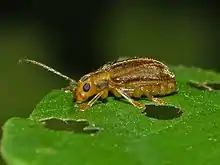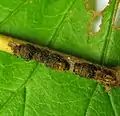Viburnum leaf beetle
Pyrrhalta viburni is a species of leaf beetle native to Europe and Asia, commonly known as the viburnum leaf beetle. It was first detected in North America in 1947 in Ontario, Canada. However, specimens had been collected in Annapolis Royal, Nova Scotia in 1924. In 1996 it was discovered in a park in New York, where native plantings of arrowwood (Viburnum dentatum complex) were found to be heavily damaged by larval feeding.[1] The UK-based Royal Horticultural Society stated that its members reported Pyrrhalta viburni as the "number one pest species" in 2010.[2][3] Female beetles burrow into viburnum terminal twigs and create 'spaces' in pith tissue. Then they lay eggs in clusters and cover them with frass. Eggs overwinter in these cavities where they are protected from water loss and predation.[4]
| Pyrrhalta viburni | |
|---|---|
 | |
| Dorsal view | |
 | |
| Lateral view | |
| Scientific classification | |
| Kingdom: | |
| Phylum: | |
| Class: | |
| Order: | |
| Family: | |
| Subfamily: | |
| Genus: | |
| Species: | P. viburni |
| Binomial name | |
| Pyrrhalta viburni (Paykull, 1799) | |
The spined soldier bug, Podisus maculiventris is used and developed as a biological control agent against the beetle.[1]
 Egg cases
Egg cases Eggs
Eggs.jpg.webp) Larva
Larva Leaf damage
Leaf damage Mating
Mating
References
- Desurmont, G.; Weston, P. A. (2008). "Predation by Podisus maculiventris (Say) (Hemiptera: Pentatomidae) on Viburnum Leaf Beetle, Pyrrhalta viburni (Paykull) (Coleoptera: Chrysomelidae), Under Laboratory and Field Conditions". Environmental Entomology. 37 (5): 1241–1251. doi:10.1093/ee/37.5.1241. ISSN 0046-225X. PMID 19036203.
- "Top 10 pests". Wisley, England: Royal Horticultural Society. 19 January 2011. Archived from the original on 9 October 2013. Retrieved 4 September 2014.
- "Viburnum beetle". Wisley, England: Royal Horticultural Society. 2014. Retrieved 4 September 2014.
- "How to win the battle against the viburnum beetle". The Daily Telegraph. Retrieved 2015-05-02.
External links
- Viburnum leaf beetle on the UF / IFAS Featured Creatures Web site
- PEST ALERT: Viburnum Leaf Beetle
- Penn State College of Agriculture
- Gardeners' World
- Bugguide.net. Species Pyrrhalta viburni - Viburnum Leaf Beetle